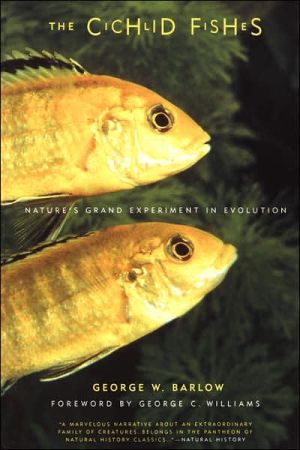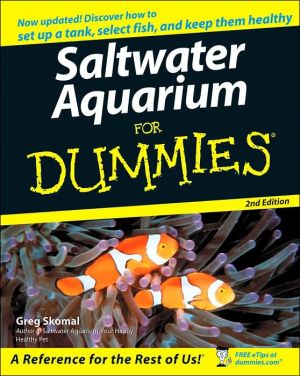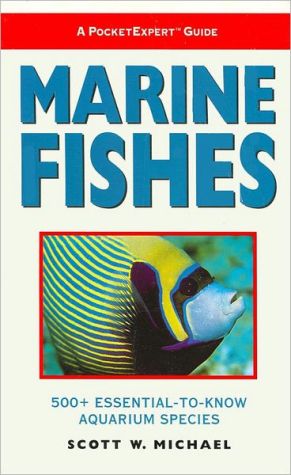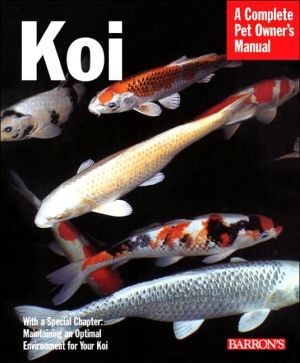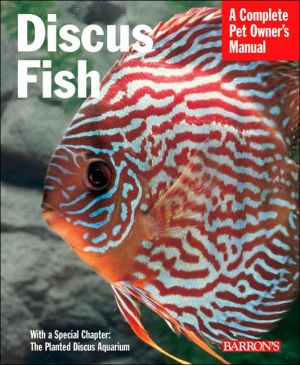The Cichlid Fishes: Nature's Grand Experiment in Evolution
Cichlid fishes are amazing creatures. In terms of sheer number of species, they are the most successful of all families of vertebrate animals, and the extent and speed with which they have evolved in some African lakes has made them the darlings of evolutionary biologists. With warmth and wit, Barlow describes the remarkably high intelligence of these fishes, their complex mating and parenting rituals, their bizarre feeding and fighting habits, and their highly unusual adaptations. A...
Search in google:
"The Cichlid Fishes is a marvelous narrative about an extraordinary family of creatures. Barlow's fertile synthesis belongs in the pantheon of natural-history classics."-Natural History Natural History - Les Kaufman The Cichilid Fishes is a marvelous narrative about an extraordinary family of creatures.
\ \ \ \ Chapter One\ \ \ SO, WHAT IS A CICHLID?\ \ \ You study what?" said the woman seated next to me on the airplane. She had a half smile on her face, partly amused, partly curious.\ "Cichlid fishes," I said again.\ "So, what's a cichlid fish?"\ No matter how many times people respond like that, I am always at a loss when I try to explain what a cichlid is. When people first see the word written, they often mispronounce it, apparently inspired by Chiclets gum. Cichlid is pronounced sick-lid.\ The name does sound odd, probably because it doesn't connect with anything familiar. If you are a bird watcher, however, you might have been struck by the shared Greek root in the scientific name of some birds, the thrushes.\ The ancient Greeks referred both to thrushes and some Mediterranean sea fishes as Kichle. Why the names were shared is uncertain and has provoked creative suggestions. The marine fishes are the wrasses, close relatives of cichlids. Several hundred years later, when scientific names were first applied to animals and plants, the groupings were much larger than those we use today. The first cichlids were lumped with the wrasses as Labrus, which became the family Labroidae. At the beginning of the nineteenth century, the few known cichlids were split off by the eminent German ichthyologists Bloch and Schneider under a new name, Cichla. About half a century later the cichlids were elevated to family status, the Cichlidae.\ Sometimes when explaining what a cichlid is I start by searching for common ground, the shared experience, such as some other kind of fish that looks like a cichlid and that the individual might have seen. A green sunfish is a case in point. People who fish in North America may have caught a green sunfish, and that fish has the same general look to it as many cichlids. If they have never seen a green sunfish, I often mention other sunfish familiar to anglers, such as the bluegill, or even the related largemouth bass.\ As a last resort I ask the person if they have ever seen a freshwater angelfish. Lots of people have, because it is both a common and a memorable aquarium fish. Its exquisite shape, a compressed disk led by a small pointed mouth and outlined by long trailing fins, together with a body of silver slashed by bold black bars, leaves a lasting impression. A stylized rendition of the angelfish is often used as a logo for aquarium stores and books and in other places, too. Those who saw the movie A Fish Called Wanda might even know that Wanda was an angelfish. Unfortunately for the point I want to make, the angelfish is a highly specialized cichlid, and only a few other species of cichlids look like it. Besides, many people think of the coral-reef angelfishes. They also look like a pancake on edge, but they are only remotely related to the cichlid angelfish.\ Another difficulty is that to answer the question of what a cichlid is presupposes that the person has some appreciation of how fishes are classified by ichthyologists. Where do the cichlids fit in among the familiar species such as sharks, minnows, trout, herring, tuna, and red snapper? Most biology students cannot adequately answer that.\ \ \ FISHES RULE\ \ \ Many are stunned to learn that the waters of our planet are populated by more species of fishes than all the other species of vertebrate animals, more than all the amphibians, reptiles, birds, and mammals put together. No one knows for sure how many species of fish exist. Each year, on average, 230 new species are described, which makes them not only the most species-rich of vertebrate animals but the fastest growing as well. Bill Eschmeyer supervises the cataloging of named fishes, and he estimates the number of species ultimately will reach between 27,500 and 30,000. Of these, cichlids contribute around 2,000 species, perhaps more; just numerically, they are one of the most important families of fishes.\ Collectively, fishes are also more diverse than all the other vertebrate animals. Some ichthyologists divide fishes up into groups as trenchantly different from one another as birds and mammals. The jawless fishes, which are the hagfishes and lampreys, are put into their separate group, as are the sharks and rays.\ In the course of evolution, fishes have many times produced spectacular bursts of speciation called radiations, like the bursts of rockets on the Fourth of July, which have faded from the scene, leaving only fossils behind. The first vertebrate animals were fishes, such as the placoderms and ostracoderms. These strange armored, jawless fishes were plentiful at the time when the first fossils became abundant, and thus existed long before the dinosaurs. They were replaced by successive radiations of more advanced fishes, such as the sharks and their relatives.\ Well before the time of the dinosaurs, fishes gave rise to the amphibians, and hence to the land-dwelling vertebrates. Thus fishes were key species in the evolution of four-legged animals, the tetrapods. These early lobe-finned fishes branched off into a few lines of evolution that diverged from those that led to our advanced fishes. Therefore, to think of modern fishes as having been the precursors of four-legged animals is a mistake. They were not. They have had their own distinctive radiations, and if anything, they evolved away from being like tetrapods. I mention this because so many people know that fishes are in our ancestral lineage, but they extend this to the belief that those ancestors were just like modern bony fishes, which include the cichlids. You are most emphatically not descended from a cichlid.\ \ \ SORTING OUT THE KINDS OF FISHES\ \ \ The modern bony fishes, called teleosts (which means true bone) arose about the time the dinosaurs were becoming extinct. The teleosts started displacing their ancestral fishes, which were much like our existing bowfin, alligator gar, and sturgeon. About 95 percent of all living species of fishes, including cichlids, are teleosts. These remarkable and diverse animals, considered the modern fishes, can be arrayed starting with those representative of primitive stages in the evolution of teleosts to the most advanced. (Some evolutionary biologists prefer to say plesiomorphic as a more objective term than the familiar ancestral, basal, or primitive, which I continue to use here. I will also apply interchangeably the vernacular terms advanced or derived.) The true bony fishes are often divided, almost for convenience's sake, into the more primitive soft-rayed and more advanced spiny-rayed fishes, though this is only a rough division.\ \ \ The Soft Kinds\ \ \ The most primitive teleosts have relatively few species and are represented by the likes of herring and anchovies, eels, tarpon, and arapaimas (a group of freshwater fishes called bonytongues), and some deep-sea fishes. They are much like modern teleosts in their basic body structure and in details of their anatomy, such as their heart and gills. But at the same time they differ in many ways. Their mouth structure is less advanced, as are many other features of their general morphology.\ That leaves the more advanced teleost fishes, consisting of about 20,000 described species in almost 400 families. The ancestral fishes here have the look and feel of being nonprickly. Representative familiar kinds are pike, trout and salmon, and true smelt. They lack spines in their fins, so they do not stick you when you handle them. Their scales, called cycloid, have smooth rounded edges. And their jaws are simpler than those of more derived bony fishes.\ The characteristic that makes fishes of this level of organization so readily recognized is the placement of their paired fins, the counterparts of mammalian legs and arms: The pelvic fins are located on the underside toward the rear of the fish, and the pectoral fins are positioned almost on the bottom side of the fish just behind its head.\ \ \ Spiny Fishes\ \ \ In contrast, the typical advanced bony fishes, such as cichlids, look and feel prickly. They have spines in their fins, and their scales are rough to the touch due to the tiny teeth on them. The sharp, piercing spines that lead the dorsal and anal fins, and the strong one that supports each pelvic fin, make it difficult for predators to swallow them. So when I read the heading to an article in our local newspaper, the San Francisco Chronicle (1 April 1997), I knew both it was not an April Fool's Day joke and that the fish was most likely a cichlid, and it was.\ \ \ Man Chokes on Tropical Fish Bayou Vista, La. Stephen Hill Epperson, 36, popped a friend's 6-inch tropical fish into his mouth as a joke Sunday and died when it got stuck in his throat. The Jack Dempsey fish became wedged in Epperson's airway, said Dr. F. H. Metz, coroner for St. Mary Parish.\ \ \ The Jack Dempsey is indeed a cichlid and performed the typical response of a spiny-rayed fish when engulfed by a predator: It locked its fin spines in the upright position to thwart being swallowed. Had the fish been a soft-rayed fish, such as the goldfish that have so often been safely gulped down by college students, the unfortunate Mr. Epperson would still be alive. The tragic ending of this story brings home a forceful message about one adaptive function of spiny fins in fishes in general and cichlids in particular.\ But to continue with the characterization of the advanced fishes, the positions of their fins also make them easy to separate from the soft-finned teleost fishes. The once-rear pelvic fins have moved forward to lie on the underside of the fish just behind the head. As if to make room for them, the pectoral fins have migrated up onto the side of the fish. The list of such advanced modern fishes is endless and includes the snappers and grunts, bluefish, butterflyfish, bass, groupers, drums, and jacks, and on and on.\ Most of the advanced species are in a group named the Percomorpha. That category is called a series in some classifications. The Percomorpha now rule the marine environment and the fresh waters of Australia but are otherwise not usually dominant in fresh waters. This huge category of fishes has slightly more than 200 families, including the Cichlidae, and about 12,000 species.\ The percomorphs, however, frustrate most facile attempts to characterize them. The exact limits and composition of this cluster of species is still disputed by systematists. Many of the families have evolved bizarre specializations and body shapes that make them seem almost not fishes at all. The boxfishes and seahorses, to cite two instances, simply do not conform to one's concept of a fish.\ Some advanced fishes seem to have reversed evolution to become primitive-appearing, such as the emergence of "eel impersonators" that are not related to eels at all. Even some of the relatively typical modern fishes have changed their scales from ctenoid to cycloid or none at all, as among many gobies. Others have reduced or lost spines in the fins and have moved the pelvic fins yet further forward to attach to the throat.\ A ladder-like arrangement from primitive to advanced, as I have been intimating, is misleading. For instance, one of the most challenging groups to classify is the superorder Ostariophysi because they do not fit easily into a linear classification. These are the minnows, suckers, catfishes, gymnotids, characins, and a primitive group that has a few marine representatives.\ The Ostariophysi are characterized by a baffling mixture of primitive and advanced features. For instance, their scales and the arrangement of their fins could be said to be primitive, yet they have the most highly specialized ears of any fishes. Further, some of the Ostariophysi have evolved secondary spines in their fins by coalescing and reinforcing fin rays. Many different kinds of catfishes have such spines in their pectoral fins, and they are often equipped with poison glands as well.\ These are the foremost fishes of the fresh waters of the world. For this reason, they bear remembering because their relationship to the cichlids for dominance of freshwater habitats comes up near the end of the book when I consider the amazing evolutionary radiations of cichlids.\ The other difficulty in classifying families of perch-like fishes is that seldom does one or a few characteristics serve uniquely to distinguish one family from the other. Instead, the focus is on a singular mixture of traits, like the code to a combination lock. These traits often involve details of the complex skull, which are not immediately apparent to the observer. We can expect to see molecular biology help clarify relationships in the coming years. Within the Percomorpha is the order Perciformes, which are the more typically perch-like fishes; the group is also hard to define because of the combination of characteristics that sets them apart.\ \ \ PUTTING THINGS IN ORDER\ \ \ Let's pause to consider how animals are classified. I will not be calling on this vocabulary much in what follows, but understanding the hierarchical nature of classification helps keep the confusion down. Think of living things arranged in several libraries, each building corresponding to a Kingdom, and each containing up to millions of books. The library we are interested in houses the animals. It has multiple floors, and each floor corresponds to a Phylum of living organisms. On each floor, rooms full of related books are called Classes. And within each room are many sets of book shelves, each set of which holds all the books belonging to one Order. Each shelf in the Order represents a family, and each book on the shelf is a Genus (plural Genera). A book, a Genus, can have from one to several pages, and these are our species.\ In this odd library, the books are loose-leaf so that species can be moved from genus to genus as the page is better understood. The same applies to all the books: The genera may be moved about among families. Generally, the higher the level of classification, the less likely are any moves, though a few still occur.\ A final quirk is that the librarian sometimes has difficulty deciding whether a book and its pages should be moved up or down the hierarchy. Taking the easy way out, subcategories are used between most of the categories. We know these, for instance, as Subgenera or Supragenera, Suborder or Superorder. Even these semi-steps don't suffice, so terms such as Series, Grade, and Division have sprung up, or at the lower end, subfamilies and tribes. Table 1.1 presents a bare-bones hierarchical classification of cichlid fishes, which you may want to refer to at times. Note that the specific terms and the form in which they are given, as well as where to divide the steps, varies among authorities. I have taken as my guide the recent treatise of ichthyology by Gene Helfman, Bruce Collette, and Douglas Facey.\ \ \ TABLE 1.1 Hierarchical Classification of Cichlids\ \ \ Phylum Chordata: the vertebrates and their early forms\ Subphylum Vertebrata: animals with vertebral column\ Superclass Gnathostomata: jawed fishes\ Grade Teleostomi: bony fishes\ Class Acanthopterygii: ray-finned fishes\ Subclass Neopterygii\ Division Teleostei: modern bony fishes\ Superorder Acanthopterygii: spiny-rayed fishes\ Order Perciformes\ Suborder Labroidei\ Family Cichlidae\ The classification of animals and plants that we use today has a long and colorful history. Although others preceded him, the great eighteenth-century biologist Carolus Linnaeus was the one who laid out the formal scheme of classification that we still use today. (He was born Carl von Linné but as happened to so many of the species he described, he changed his name to the Latinate form Carolus Linnaeus.)\ The Linnaean system is called binomial because each species has two names, and they are arranged like a Chinese person's name. I say that because the second name in this binomial nomenclature is the unique name of the species, and the first name designates the genus to which the species belongs. Hence several species may share the generic name if they are closely related. By convention, binomial names are italicized. When a person's name follows the genus and species, that tells you who first described the species. But the name is often given in a form that contains yet more information.\ Take the species I have studied for several years, which has the common name of the Midas cichlid. Its original name in its full glory was Heros citrinellus Günther 1864. The generic name comes from the Greek Heros for a female with heroic qualities. The species name finds its root in the citrus tree (Gr. kitrea, L. citrea) because the first specimen was yellow. The two-part scientific name is followed by that of the person who formally described the species, Günther, who was an ichthyologist at the Museum of Natural History in London. The year, 1864, informs the reader when Günther's description of the species was published in order to make it easier to search the literature for the original description.\ Lay people often think that one of the great discoveries of biology is a new species. Actually, that is a relatively humdrum though important milestone. New species are described regularly. A further misconception is that when a scientist discovers a new species she can, or will, name it after herself. Not so. That is considered bad form in the scientific community. The describer typically names the species for some distinctive feature, such as the yellow color of Heros citrinellus. Sometimes the place where the species was found is used for the species name, simply adding -ensis or -ense, depending on gender, to the end of the name, as in nicaraguense. When the species is named after a person, the usual ending is -i, as in the colorful and popular cichlid fish from Lake Victoria called Haplochromis neyererei in honor of the great African leader and first president of Tanganyika, Julius Nyerere.\ In practice, the name of the describer and the year are often dropped in nontaxonomic articles. If the name is used frequently in an article, and the context is clear, the genus is indicated by just the first letter, for example, H. citrinellus.\ The science of how organisms are named is called taxonomy, and the people who do that are taxonomists, in addition to being, say, ornithologists or entomologists. Some distinguish between taxonomy and systematics, though the two areas overlap broadly and individuals who do the one commonly do the other. Taxonomy addresses the work of describing diversity and how to identify species as well as arranging them into systems of classification. Systematics tends more toward relationships at higher levels of classification. I use the terms interchangeably in this book.\ Taxonomy has a number of practitioners and remains a dynamic field of research. One consequence of that dynamism is that animal names, and how they are classified, often change, much to the consternation of others who prefer a fixed taxonomy that does not challenge one's memory.\ Returning to the Midas cichlid, a later taxonomist reclassified it by putting it into a different genus. Thus he created the new combination Cichlasoma citrinellum (Günther). The parentheses around Günther's name indicates that he described the species, but not in the genus Cichlasoma. The ending of the species name changed to agree with the gender of the new genus.\ The binomen (two-name combination) does not inform you, however, about the times when subsequent ichthyologists collected specimens of C. citrinellum and erroneously described them as new. When such mistakes are discovered, the latecomer is said to be a junior synonym of C. citrinellum and disappears into its synonymy.\ Fish hobbyists hate it when ichthyologists revise the names of species and genera, especially when a well-accepted species name vanishes into the synonymy of some obscure species name. Understandably, that produces howls of complaints about the metamorphosing nomenclature. Scientists are more conservative about the names of plants and animals than the amateurs; and taxonomists have specified rules of nomenclature. Common names, in contrast, vary regionally and change whimsically through time, not to mention the reality that the common name is different in almost every language, whereas the scientific name remains unchanged. Despite that, I try to use widely accepted common names when possible. Unfortunately, the Cichlidae is a large family and most species do not have common names.\ But, you may well ask, why do scientists change a fish's name? Generic names get switched around as the understanding of relationships improves. As more species are described, and as we gain a more fundamental understanding of relationships, species are regrouped to reflect the new knowledge. Name changes simply reflect the lively state of the field. The generic status of C. citrinellum, for instance, is unclear as I write.\ The formerly large genus Cichlasoma embraced species from southern Texas to the Amazon basin in South America, but recently it was restricted to a small number of species in South America. As a result, the generic status of the numerous other species were left in limbo, though many aquarists have elevated the subgenera suggested by Robert Miller to the status of full genera. C. citrinellum has been placed in other genera in the past, but which of those names should be used remains controversial. The most likely generic name in the future is Amphilophus.\ Until the question is resolved, systematists have decided to keep the same generic name; but to let the reader know the genus is tentative it is by convention marked in single quotes, that is, `Cichlasoma' citrinellum. I am less conservative with the names of African species because revisions of their nomenclature are further along.\ (Continues...)\ \ \ Excerpted from THE CICHLID FISHES by GEORGE W. BARLOW. Copyright © 2000 by George W. Barlow. Excerpted by permission. All rights reserved. No part of this excerpt may be reproduced or reprinted without permission in writing from the publisher. \ \ \ \
ForewordixPrefacexiiiIntroduction11So, What Is a Cichlid?72Jaws Two283Plastic Sex514Mating Games645Oh Yeah? Put Up Your Fins!906Cichlid Speak1067Beauty Is Only Fin Deep1188Mating Gets Personal1339How Gametes Meet15310Family Plan17311Family Life Gets Complicated20112Cichlid Factories22013Fish at Risk251Glossary269Numerical Guide to Citations275References293Index317
\ ScienceThe author's lifelong enthusiasm for cichlid watching...is amply conveyed and contagious.\ \ \ \ \ Les KaufmanThe Cichilid Fishes is a marvelous narrative about an extraordinary family of creatures. \ — Natural History\ \ \ Science Books and FilmFor those interested in...natural history, this... is a treasure trove; for those interested in cichlids, it's a must.\ \ \ \ \ Publishers Weekly\ - Publisher's Weekly\ With more than 1,000 species and countless more subspecies native to the freshwaters of Africa, Asia and South America, the family of Cichlid fish are perhaps evolution's greatest success story. Diverse in color, size and behavior, these fish are of equal interest to fishermen, ethologists and home aquarium enthusiasts. Barlow, Professor Emeritus of Integrative Biology at the University of California at Berkeley, presents a multifaceted study of these unusual creatures. Like some higher mammals and birds, many Cichlid species are monogamous. In some species the size, color and health of the male attract the female; in others, the nesting site's design lures mates. Often, males as well as females participate in nurturing and raising the young, using their mouths as havens for incubating eggs and to protect their fry from predators. Cichlids provide a seemingly unending source of information for ichthyologists, behaviorists and geneticists in their quest to understand speciation and animal intelligence. They are also valuable to aquaculturists, who can breed certain species as a protein source for human consumption. In this diligent and enthusiastic book, Barlow opens an underwater realm that will fascinate scientists and lay readers alike. Illus. (Dec. 18) Copyright 2000 Cahners Business Information.\ \ \ \ \ Library JournalCichlids are a fascinating group of some 2000 marine and freshwater species. While Tijs Goldschmidt's Darwin's Dreampond (LJ 10/1/96) discussed the varieties of cichlid species in Lake Victoria, Barlow (integrative biology, Berkeley) studies the cichlids in all the East African lakes, showing their true variation. As an ichthyologist, he has studied cichlids extensively and presents solid scientific information about them in a way that is accessible to the non-expert. Barlow begins by covering the factors that promote evolutionary survival: coloration (cichlids change more elaborately than chameleons); communication using stance, color, and sound; parenting (cichlid species care for their offspring); and, mostly extensively, cichlid courtship and mating. He also covers structure and genetics from a systematist's and a molecular biologist's perspective, respectively, and offers an extensive bibliography for further research. Scientific terminology is minimized but appropriate, and a useful glossary is included. Like any good scientist, Barlow raises as many questions as he answers. Cichlids are popular aquarium fish, so hobbyists would be interested in this book, although that is not its focus. This should be the classic in the field for a long time. Recommended for academic and public libraries.--Jean E. Crampon, Univ. of Southern California Lib., Los Angeles Copyright 2000 Cahners Business Information.\ \ \ \ \ From The CriticsThis is a paperbound edition of a 2000 book. Barlow (integrative biology, U. of California-Berkeley), a foremost expert on this family of fish, examines how these fish have evolved into hundreds of different species in the Great Lakes of East Africa, and explores the implications of their rapid speciation for the understanding of evolution. These fish are prized by US hobbyists for their colors and because they are so easy to rear in an aquarium; they are at risk of extinction from human-planted Nile perch in their native waters. Annotation c. Book News, Inc., Portland, OR (booknews.com)\ \ \ \ \ BooknewsConsidered a foremost expert on them, Barlow (integrative biology, U. of California-Berkeley) examines a family of fish that has evolved hundred of different species in the Great Lakes of East Africa and are prized by US hobbyists for their colors and because they are so easy to rear in an aquarium. He also describes how they are at risk of extinction from human-planted Nile perch in their native waters, and explores the implications of their rapid speciation for the understanding of evolution. Annotation c. Book News, Inc., Portland, OR (booknews.com)\ \
